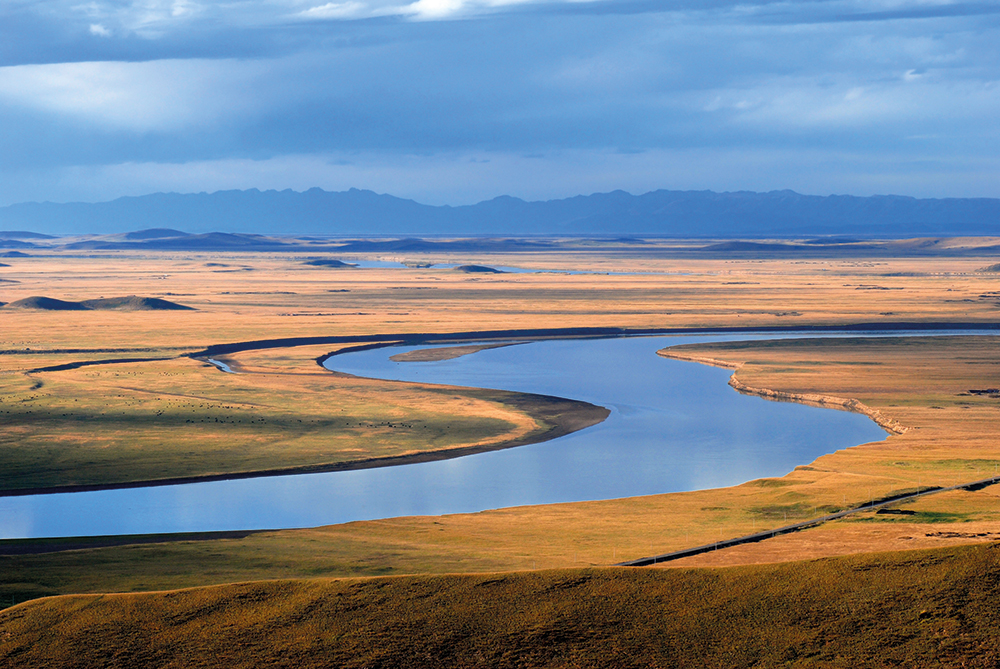
That rivers have a life of their own is an ancient idea become current again. Shape-shifting, vital and recognisably capable of being sickened or damaged – as the state of our fragile chalk streams so starkly illustrates – there is good reason why fluvial myths have such historic potency and why the flow of water enjoys so many figurative associations.
The late James C. Scott, an amateur hydrologist and professor of anthropology at Yale, who died in July last year, opens his nicely fluent study with an unequivocal assertion – ‘Rivers, on a long view, are alive.’ In Praise of Floods examines the several ways in which homo sapiens have sought to tame and exploit watersheds, and the importance of floodplains in human culture. He notes the grim engineering view, espoused by Stalin among others, that a river which reaches the sea is merely an under-utilised resource, whereas in his view, if it is dammed, it is being denied its proper destiny.
Ranging widely from China’s Yellow River to the intricate meander belt of the Mississippi, he stresses the implications of a river’s lateral movement and zooms in on an ‘eco-biography’ of Burma’s Ayeyarwady, the worship of its spirits and the history of its denizens. Some of them – snow carp, Oriental darter and smiling turtle – he boldly imagines speaking out for themselves in the face of overfishing, mining pollution, abstraction and obstruction, in the hope that such diverse waterways will not ultimately be squeezed of all life. But the outlook is gloomy unless we wise up soon, and he quotes Hegel: ‘The owl of Minerva flies only at dusk.’
You may indeed never be able to step into the same river twice, but Robert Macfarlane’s impassioned and invigorating new book overlaps in certain respects with Scott’s, not least in a shared vision of the essential anima of what he prefers to call ‘waterbodies’. Is a River Alive? is divided into three parts, each interspersed with a seasonal visit to chalk-fed springs near his Cambridgeshire home which are effectively the fons et origo of his fascination with the ‘numinous power’ of water since he was ‘a boy with flaxen hair’.
A sweeping prologue establishes the deep time perspective of what follows and explains the concept of ‘daylighting’, whereby buried streams are allowed to meet the sun again. The book’s ambition, then, is ‘to daylight long-buried ways of feeling about water’, which have become commodified and demystified into ‘inanimate brute matter’ (the phrase is Isaac Newton’s). Following a catalogue of alarming details (the Yangtse catchment is now saddled with 50,000 dams; Lake Ontario was once so polluted you could develop photographic film in a bucket of its water), he declares: ‘Rivers should have rights.’ And so, in various landmark rulings from New Zealand to Quebec, they are beginning to have.
Despite for centuries sustaining a civilisation where water was revered, Chenai’s rivers are poisoned to death
Part One takes us off to the cloud forests of northern Ecuador where our intrepid author plans to trace the source of the Rio Los Cedros, along with a cast of colourful characters. These include Giuliana Furci (a recently bereaved mycologist and dowser) and the puckish field sound recordist Cosmo Sheldrake. Despite a piece of recent enlightened legislation, this region is still under threat from wildcat mining and drug cartels. But it remains a richly biodiverse hinterland, ‘a living Wunderkammer’, home to the devil’s fingers fungus and the golden-headed quetzal. Macfarlane relishes this plenitude, and the physical challenges of the climb into an ominous ‘cloud of unknowing’. Along the way he discusses the Epic of Gilgamesh and Ursula Le Guin with a grizzled, radical backwoodsman named Josef DeCoux, whose reply, when asked about the weather prospects, is: ‘Rain. More rain. This is a cloud forest, after all – what the fuck do you expect?’
In full flow, Macfarlane resembles his late friend Barry Lopez (the author of Arctic Dreams) and also the formidable John McPhee, whose classic trilogy Annals of the Former World won a 1999 Pulitzer. In his introduction to the 2015 reissue of McPhee’s Alaskan masterpiece Coming Into the Country, Macfarlane praised the ‘date-stamped immediacy’ of its style and its ‘astonishing cargo of details’. His own work commands a similar lucidity, while marshalling an impressive field of reference material relating to complex topography and deep mapping. Crucially, too, Is a River Alive? is not without humour – maybe not the jauntiness of Redmond O’Hanlon, but a leavening touch nonetheless, though at times Macfarlane can sound intellectually uncompromising: ‘One of modernity’s many vanishing tricks is to disappear the provisionality of its own conclusions.’ Sharpen up there, lector benevole!
It’s not hard to see why this author’s writing outstrips many others in its international success. Macfarlane is erudite and eclectic, and, though charismatic, doesn’t press his presence upon you. His books are adventurous, often involving truly remarkable companions; and at the sentence level no one could accuse him of painting by numbers. Here the prose is splashed with those little starbursts of naturalistic description we have come to expect – a wood pigeon ‘flaps away like dropped crockery’; a vast millipede proceeds ‘unhurried and steampunk’; ‘two toucan barbets call out their counterpoint duet in smoky hoots’. The book celebrates the diverse flow of life, but also contemplates gradual and inexorable extinction. For our present planet Earth epoch Macfarlane favours E.O. Wilson’s designation ‘the Eremocene’ – the Age of Loneliness.
The second part concerns India, where the mission is to travel the course of Chennai’s three rivers which empty into the Bay of Bengal. Despite for centuries sustaining a civilisation where water was revered, these waterbodies are now being poisoned to death by pollution, and chronic mismanagement is subjecting the city to ‘a brutal cycle of flood and drought’. Helping him investigate this drastic ‘rivercide’ is the young self-taught naturalist Yuvan Aves, author of Intertidal (2023), who has escaped a brutal past. His astonishing personal metamorphosis forms the most arresting aspect of this section, which otherwise lacks the narrative focus and hydraulic cohesion of the rest of the book. As a chronicle of governmental contempt for the environment, however, it speaks clearly enough. When the wellbeing of the Ennore Creek threatened to impede industrialisation and the development of power stations (a common theme), the authorities simply removed the river from all official maps.
By contrast, Part Three is Macfarlane’s pièce de résistance. He ventures into an area of eastern Canada known to the indigenous Innu as ‘Nitassinan’ (‘our land’) to kayak the perilous length of the Mutehekau Shipu river – known in English as the Magpie – which debouches into the Gulf of St Lawrence. Against a background of the Quebecois’ fierce appetite for hydro power (a compulsion to build dams nicknamed the ‘Beaver Complex’), this region is threatened with invasive schemes along the lines of the nearby Romaine system, despite it being unceded First Nations territory. One of Macfarlane’s companions is Wayne Chambliss, a fiftyish polymath with a ‘frankly supernatural memory’, prone to giving ‘mental Mulligan-stew’ monologues. He travels with a Pandora’s box of talismans and his projects include boiling an egg by moonlight (something straight out of Jonathan Swift’s Academy of Lagado). Together with a redoubtable fisherman named Ilya Klana, the author forms a posse of paddlers who face serious riverine obstacles.
Their journey has the blessing of Rita Mestokosho, a poet, healer and guardian of the Innu culture, who gives them advice on how to open their minds to the river (this includes Macfarlane leaving his notebooks behind) and promising they will return transformed. ‘She is eerily right.’ The resulting account is spellbinding in places, as the journey is physically daunting. The river is inhospitably high, and there are so many rapids the joke runs that ‘even the trout have portage trails’, though there’s nothing funny about the ordeals that follow. The journey culminates at the awesome Gorge, described in a torrential, paratactic finale which I would hesitate to call an epiphany – but somehow the river does seem to flow through Macfarlane, reshaping his vision of the world of water.
When he returns home, his young son remarks about the volume’s title: ‘Well, duh, that’s going to be a short book then, Dad… because the answer is yes!’ I spend much of my time peering into running water, and would have to agree. Might there still be time for Minerva’s owl to fly by daylight?







Comments